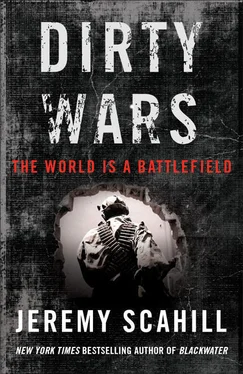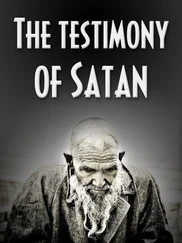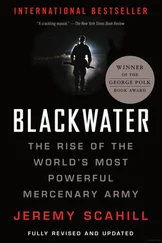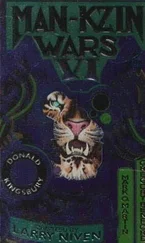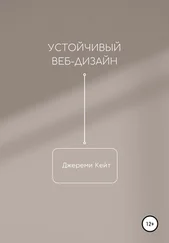“Under a secret program code-named SCREEN HUNTER, JSOC, augmented by the Defense Intelligence Agency (DIA) and contract personnel, was authorized to shadow and identify members of the ISI suspected of being sympathetic to al-Qaeda,” Ambinder and Grady wrote. “It is not clear whether JSOC units used lethal force against these ISI officers: one official said that the goal of the program was to track terrorists through the ISI by using disinformation and psychological warfare.”
Despite this incredible opportunity, neither Afghanistan nor Pakistan would be given top billing in the Bush administration’s war plan. Instead, the top-tier operators from JSOC and the CIA were again redirected to Iraq to confront the rapidly spreading insurgency, which had made a farce of the administration’s claims that US forces would be welcomed as liberators. The CIA’s unit responsible for hunting down bin Laden, Alec Station, was shut down. “This will clearly denigrate our operations against Al Qaeda,” declared former senior CIA official Michael Scheuer, the unit’s first director. “These days at the agency, bin Laden and Al Qaeda appear to be treated merely as first among equals.”
The head of the CIA’s clandestine operations branch, Jose Rodriguez, reorganized the CIA’s secret US war in Pakistan under the code name “Operation Cannonball.” In theory, it was an attempt to ratchet up the targeting of al Qaeda. But with most of the veteran CIA and Special Ops assets bogged down in Iraq, the operation was largely staffed by inexperienced operatives. “You had a very finite number” of agents with operational experience in the Islamic world, a former senior intelligence official told the New York Times . “Those people all went to Iraq. We were all hurting because of Iraq.” The secret war in Pakistan became largely a drone bombing campaign, described by CIA officers at the US Embassy in Islamabad as “boys with toys.” The drone campaign successfully took out several suspected al Qaeda figures and reportedly narrowly missed Zawahiri, but it also resulted in scores of civilians being killed, sparking protests and outrage among Pakistanis.
Although CIA drone strikes became the lead US weapon in Pakistan during this period, JSOC forces did, at times, manage to conduct sporadic ground operations, albeit “with a great deal of protest” from the Pakistanis, according to Shaffer. In a raid in 2006 in Damadola in Bajaur, Navy SEALs from DEVGRU targeted a suspected al Qaeda house and detained several people. “They choppered in, rappelled down and went into the compound,” a former US official familiar with the operation told the Los Angeles Times . “It was tactically very well executed.” Pakistani media sources characterized the operation a bit differently. “American soldiers had violated Pakistani airspace, flown to the village in helicopters, killed eight persons in the home of a cleric Maulana Noor Mohammad, and taken away five others to Afghanistan,” reported journalist Rahimullah Yusufzai.
With resources spread thin in Pakistan as a result of the intensifying insurgency in Iraq, the Bush administration began outsourcing its war in Pakistan. Enter Blackwater, Erik Prince’s secretive mercenary company already infamous for its work in Iraq. Like the CIA, Blackwater had its own cover: diplomatic security. From the early stages of the launch of the Global War on Terror, its operatives were able to deploy in large numbers to war zones as bodyguards for US officials. Blackwater was the elite Praetorian Guard for the senior officials running the US occupation of Iraq and simultaneously worked for the State Department, the Pentagon and the CIA providing security for their operations in hostile zones across the globe.
The company additionally won contracts for training foreign military forces, including Pakistan’s Frontier Corps, the federal paramilitary force officially responsible for on-the-ground strikes against suspected terrorists or militants in the tribal areas.
Meanwhile, across the border in Afghanistan, Blackwater controlled four Forward Operating Bases, including the closest US base to the Pakistan border. All of this was very appealing to both JSOC and the CIA.
According to Shaffer, among Blackwater’s roles for the CIA was training Afghan militias to do cross-border raids into Pakistan, which offered deniability to the United States. “I handled two of their—the CIA/Blackwater—KIAs [killed in action], killed while they were out on a mission… essentially performing a Special Operations mission, training Afghan cadre militia to do cross border stuff,” Shaffer recalled. He added: “This is clearly something they were doing that they didn’t like having talked about.” One of the reasons Blackwater was used, he said, “was to avoid oversight.”
Many of Blackwater’s elite operatives, particularly those who worked for its most sensitive division, Blackwater SELECT, were veterans of US Special Operations. It wasn’t hard for them, therefore, to serve two masters: the CIA and JSOC. While the CIA was, by mandate, concerned with an array of intelligence functions, JSOC had one central mission worldwide: the killing or capture of High Value Targets, HVTs. In 2006, twelve “tactical action operatives” from Blackwater were recruited for a secret JSOC raid inside Pakistan, targeting an al Qaeda facility. The operation was code-named “Vibrant Fury.” The involvement of Blackwater demonstrated how central the company had become to covert US actions.
IN 2005, Abu Musab al Zarqawi escalated his merciless campaign targeting Iraqi Shiites as well as Sunni Muslims he perceived as being weak or ineffectual. Al Qaeda’s central leadership, believing that the killing of Muslims by Zarqawi would backfire, reached out to the Jordanian militant. Ayman al Zawahiri wrote to Zarqawi in July 2005. Bin Laden’s deputy heaped praise on Zarqawi for his role in the jihad, while emphasizing that the first goal in Iraq should be to expel the US invaders. The sectarian war against Shiites, Zawahiri declared, was “secondary in importance to outside aggression” and al Qaeda in Iraq should focus on supporting a popular revolt against the Americans. Zawahiri warned Zarqawi:
In the absence of this popular support, the Islamic mujahed movement would be crushed in the shadows, far from the masses who are distracted or fearful, and the struggle between the Jihadist elite and the arrogant authorities would be confined to prison dungeons far from the public and the light of day. This is precisely what the secular, apostate forces that are controlling our countries are striving for. These forces don’t desire to wipe out the mujahed Islamic movement, rather they are stealthily striving to separate it from the misguided or frightened Muslim masses. Therefore, our planning must strive to involve the Muslim masses in the battle, and to bring the mujahed movement to the masses.
Zarqawi, however, seemed to pay Zawahiri no mind. In early 2006, Zarqawi’s group formed a Shura Council of the Mujahedeen, which promptly threatened Sunni leaders in Anbar Province—one of the front lines against the United States—that if they did not join al Qaeda, the group would “make you an example to each and every one.” In February 2006, Zarqawi’s group bombed one of the holiest sites in Shiite Islam, the Askariyya Mosque in Samarra, destroying its famed golden dome. The brief period of a unified national uprising against the Americans in Iraq was over. Zarqawi had made a tremendous tactical mistake by waging a war against the Sunni tribes in Anbar. It pushed the once anti-US tribes into an alliance with the occupation. America gave them arms, money and support in return for fighting Zarqawi’s group. Combined with the US support for Shiite death squads, the United States had succeeded in an Iraqicization of its war on terrorism.
Читать дальше
